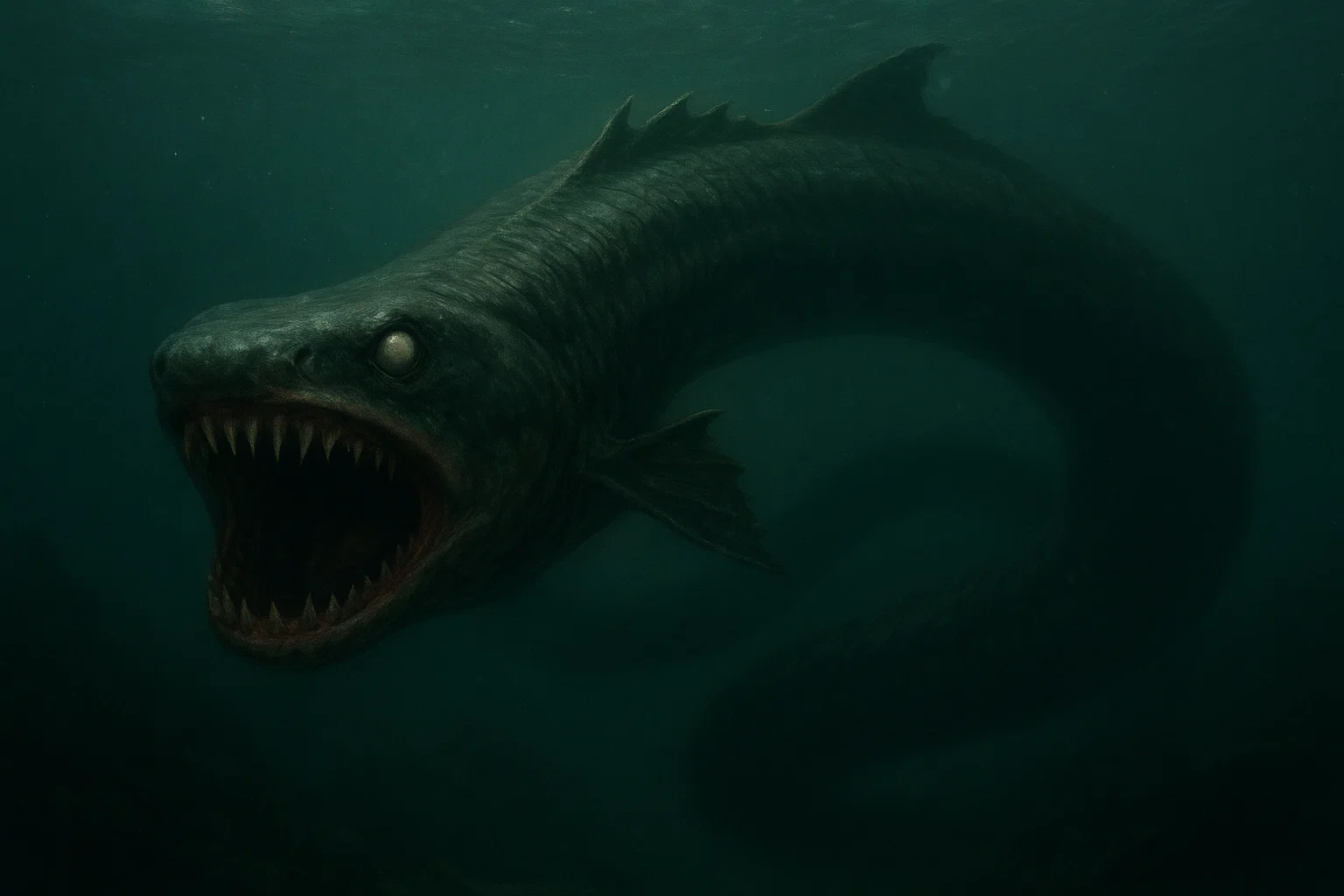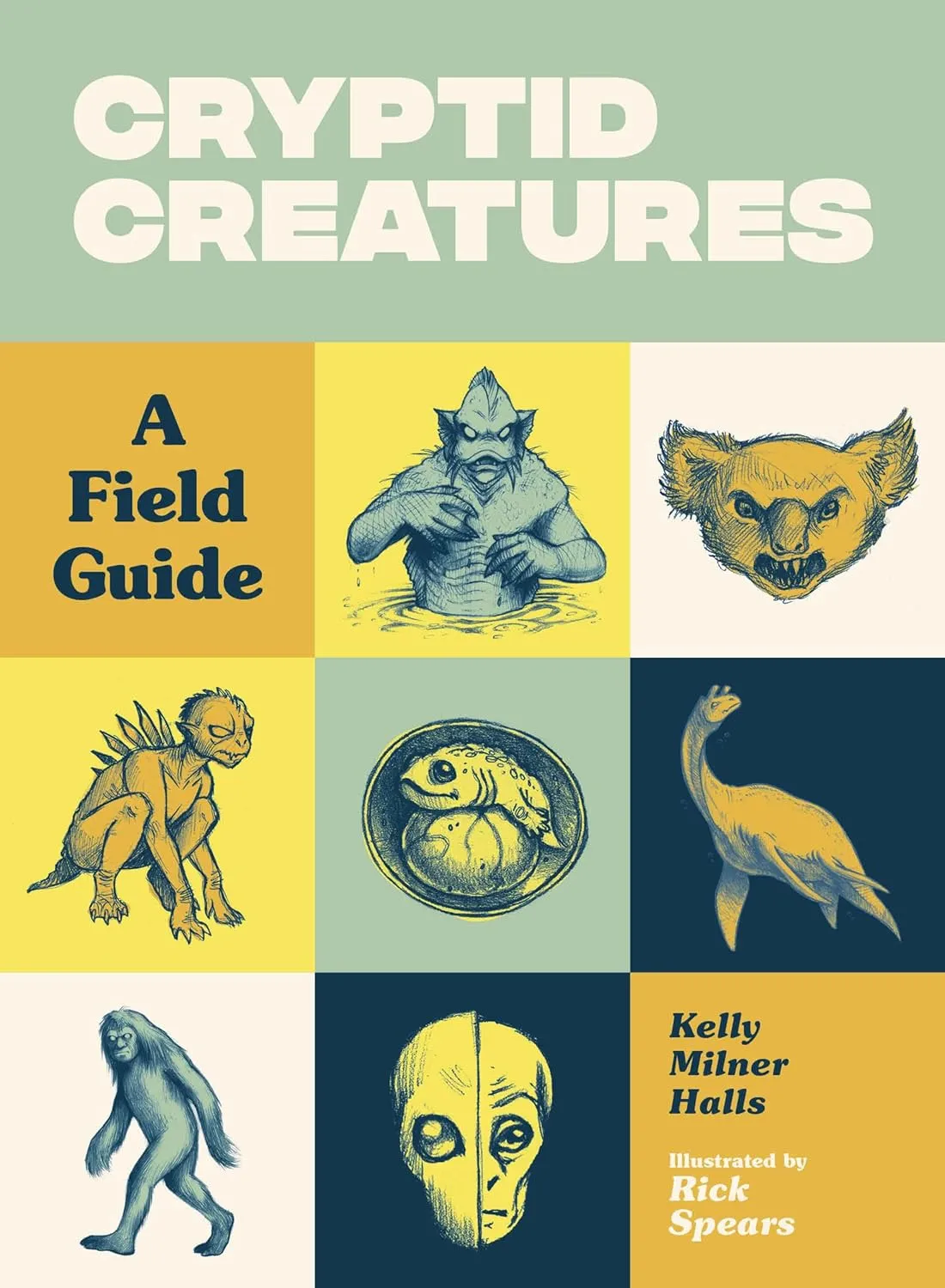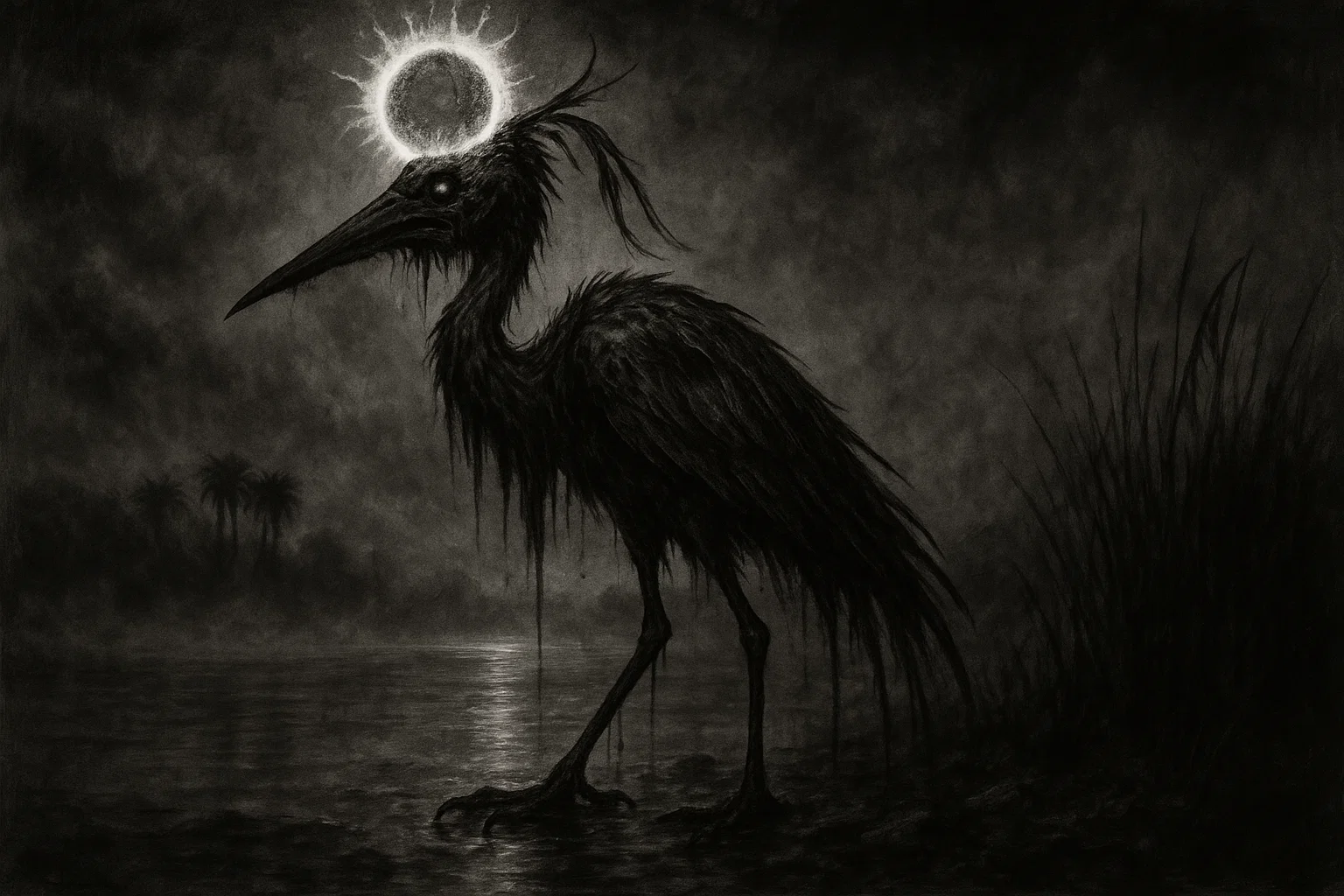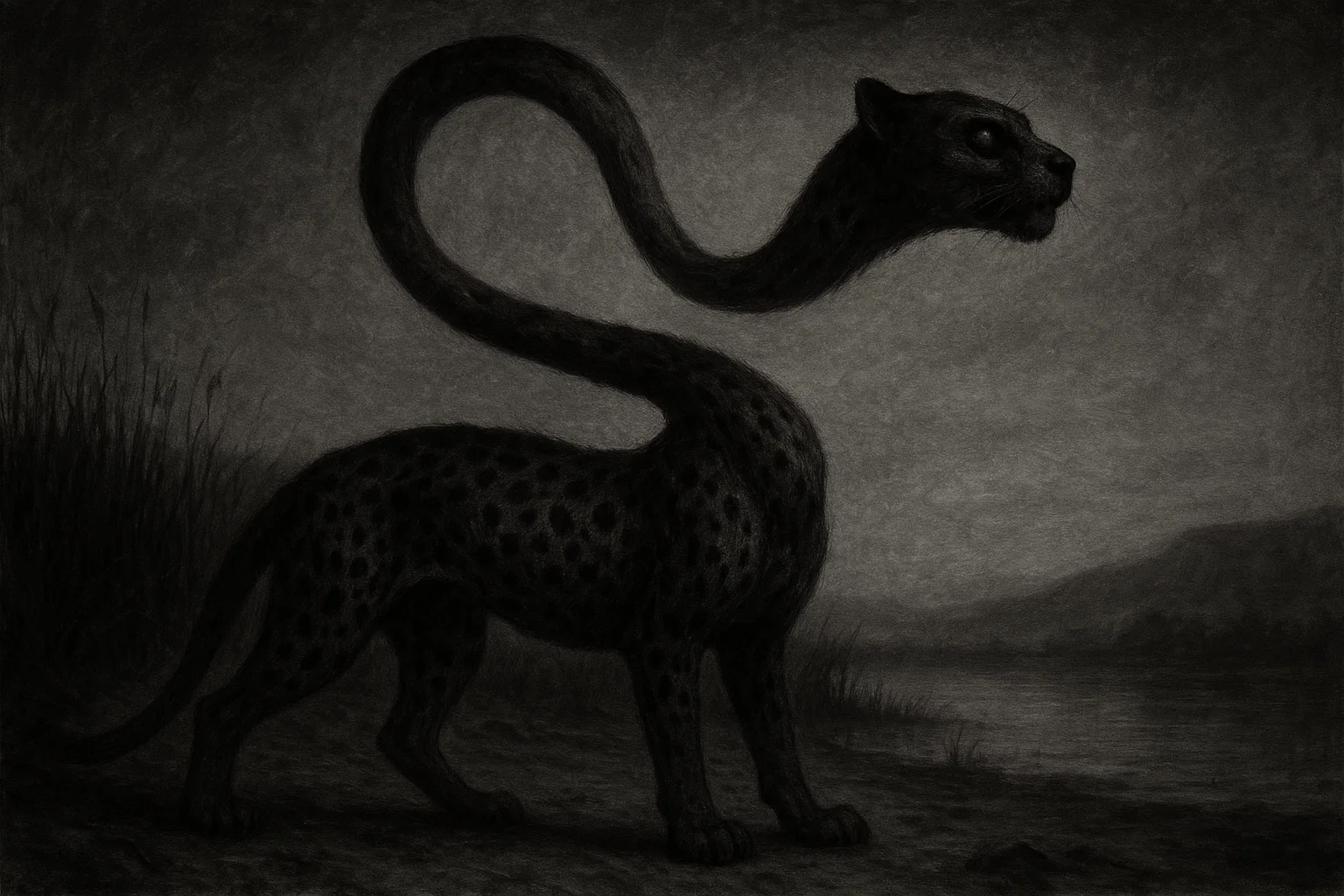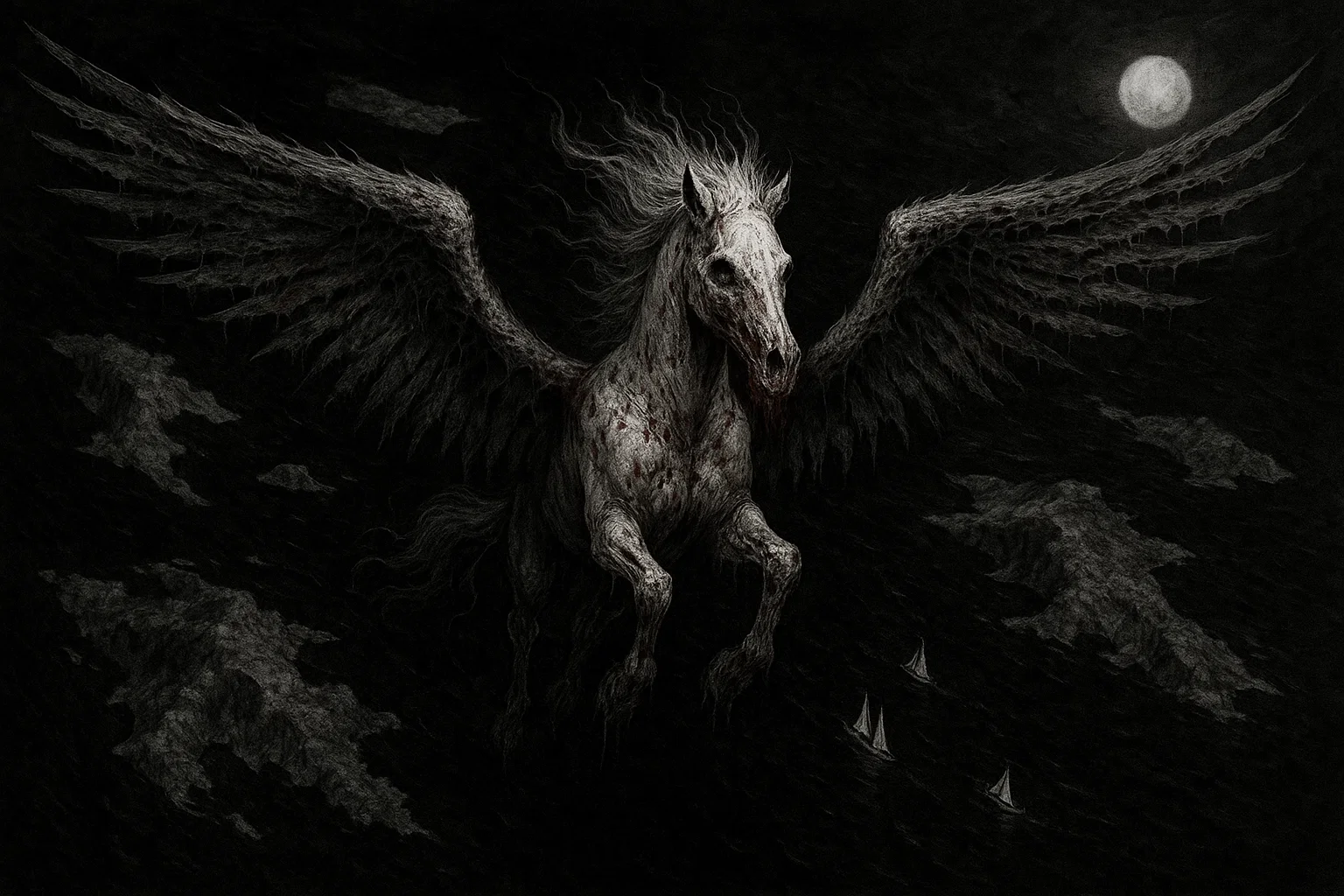The Iliamna Lake Monster, also known by the local name Illie, is a cryptid alleged to inhabit Lake Iliamna in southwestern Alaska. Reports describe the creature as a large, aquatic, fish-like organism, often measuring between 10 and 30 feet in length.
The existence of the cryptid is rooted in the folklore of local Native communities, with modern sightings being recorded since the 1940s. Its persistence has made Lake Iliamna a subject of cryptozoological interest.
Summary
Overview
| Attribute | Details |
| Name | Iliamna Lake Monster |
| Aliases | Illie, Gonkadet (Tlingit name), Jik-ik-nak (Aleut/Yup’ik name) |
| Threat Level | Aggressive (Native tales suggest attacks on canoes), Predatory (modern accounts describe hunting waterfowl and seals). |
| Habitat | Lake Iliamna, Alaska, United States |
| Physical Traits | Large, elongated, fish-like body. Reported length of 10–30 feet, occasionally up to 60 feet. Described as dull aluminum, black, or dark-colored. Possesses visible fins and a large head, sometimes likened to a wolf or shark. |
| Reported Sightings | Lake Iliamna, Alaska Peninsula; areas near Pedro Bay and Kakhonak village. |
| First Documented Sighting | Pre-19th Century (Native legends); 1942 (Modern documented report by pilots). |
| Species Classification | Unknown, possibly a large, undocumented fish species, adapted marine animal, or reptilian remnant. |
| Type | Aquatic, limnetic (freshwater, with access to marine environments). |
| Behavior & Traits | Capable of deep diving and prolonged submersion. Reported behaviors include ramming boats, herding and preying on seals and sockeye salmon, and consuming waterfowl. |
| Evidence | Eyewitness accounts (aerial and surface), damaged fishing gear, local oral histories. |
| Possible Explanations | White Sturgeon, Pacific Sleeper Shark, Beluga Whale, large Northern Pike, or misidentified seal pods. |
| Status | Ongoing mystery; actively reported in the 20th and 21st centuries. |
Who or What Is Iliamna Lake Monster?
The Iliamna Lake Monster is an unidentified aquatic creature believed to inhabit Lake Iliamna, Alaska’s largest freshwater lake. The origins of the legend predate European contact and are preserved in the oral traditions of the region’s indigenous peoples.
The Tlingit people referred to a creature called Gonkadet, described as a fish-god possessing the head and tail of a wolf on the body of an orca.5 The Aleut and Yup’ik of the region spoke of the Jik-ik-nak, a creature known to travel in groups and capable of attacking and breaching canoes.
Contemporary reports of the cryptid began to appear in the 20th century, particularly after World War II, when air travel over the remote lake increased. These modern accounts generally portray the monster as a singular, gigantic fish.
Unlike the often snake-like or long-necked morphology of many lake monsters, the Iliamna Lake Monster is consistently described as a massive, elongated fish, suggesting a possible large-bodied fish species or a marine animal adapted to a freshwater environment.
The One Book That Turned “Monster Hunting” From Joke to Actual Science
Limited-Time: Up to 46% OFF!
Bigfoot, Loch Ness, Chupacabras, Mothman, Yeti, and dozens more – the original A-to-Z encyclopedia with 100+ fully researched cryptids, eyewitness accounts, expedition histories, and the evidence that made skeptics sweat. Loren Coleman and Jerome Clark’s 1999 classic that launched a thousand investigations.
What Does the Iliamna Lake Monster Look Like?
The physical description of the Iliamna Lake Monster varies, though core elements remain consistent across multiple accounts. The creature is uniformly described as possessing an elongated, fish-like body of substantial size. Length estimates range widely from approximately 10 to 30 feet, with a few modern reports suggesting even larger dimensions up to 60 feet.
In terms of coloration, descriptions vary: some accounts describe it as dark or black, while early aerial witnesses described it as dull aluminum-colored.
The cryptid is reported to have visible fins and a large head. The shape of the head has been subject to varied interpretation, sometimes described as wolf-like, shark-like, or even square-shaped.
Accounts from hunters who witnessed the creature consuming swans described it as having large, dark eyes that were disproportionate to those of native fish. Some narratives also describe a creature with metallic scales or smooth skin.
Overall, the appearance is consistent with that of a massive apex predator adapted to the lake’s deep waters.
Habitat
The habitat of the Iliamna Lake Monster is Lake Iliamna, situated on the Alaska Peninsula in the Lake and Peninsula Borough of Alaska.
The lake is geographically significant, recognized as the largest freshwater lake in Alaska and one of the largest in North America. Its physical dimensions are substantial, measuring approximately 77 miles (124 km) long and 22 miles (35 km) wide.
The maximum depth of the lake approaches 1,000 feet (301 meters), providing ample space for a large, deep-dwelling creature.
Lake Iliamna is positioned in a remote, subarctic ecosystem.20 The surrounding terrain consists of tundra and forest, with a climate characterized by cold, long winters and short, cool summers. The lake supports a notable biodiversity, including a world-famous run of sockeye salmon.
Crucially for cryptozoological theories, the lake maintains a connection to the salt water of the Bering Sea and Bristol Bay via the Kvichak River. This connection allows euryhaline marine species—animals capable of adapting to both fresh and salt water—to enter the lake and potentially inhabit it permanently.
Furthermore, Lake Iliamna is known to host a population of freshwater seals (Phoca vitulina), which are considered a rare occurrence and contribute to the potential food sources for a large, unknown predator.
You may also enjoy:
Proctor Valley Monster: Is the San Diego Bigfoot a Minotaur?
September 24, 2025
12 Haunted Places in Arkansas You Should Never Visit Alone
October 8, 2025
The Lake Tanganyika Monster: A Living Prehistoric Beast?
November 10, 2025
The Terrifying Troll: Scandinavian Monster of Stone and Shadow
September 12, 2025
Charybdis: The Insatiable Maw That Swallows Ships Whole
December 3, 2025
Iliamna Lake Monster Sightings
Reports of the Iliamna Lake Monster have been consistent since the mid-20th century, in line with local oral histories. These accounts often originate from fishermen, pilots, and local residents.
| Date | Place | Witness Details | Description | Reliability |
| Pre-19th Century | Lake Iliamna, across villages | Tlingit, Aleut, and Yup’ik peoples | Creature known as Gonkadet or Jik-ik-nak, described as a fish-god or sea wolf; known to travel in groups and attack/ram small canoes (bidarkas). | High: Consistent, multi-generational oral history. |
| 1942 | Lake Iliamna | Babe Alyesworth and Bill Hammersley (Bush pilots) | Observed several large, elongated fish, estimated to be at least 10 feet long, with a dull, aluminum color swimming near the surface. | Medium: Two professional witnesses, observed from the air. |
| 1963 | Lake Iliamna | Unnamed Biologist | Sighted a fish estimated between 25–30 feet long from an aircraft. It did not surface for air during 10 minutes of observation. | Medium: Professional witness, but anecdotal and unnamed in sources. |
| 1967 | Lake Iliamna | Chuck Crapuchettes (Missionary/Pilot) | Witnessed a large animal from his floatplane and attempted to fish for it using steel cables and tuna bait. The craft was reportedly dragged around the lake, and the cables were severed with hooks straightened. | High: Physical evidence of gear damage, named witness for the incident. |
| 1977 | Near Pedro Bay | Tim LaPorte (Pilot) and two passengers | Spotted a 12–14 foot fish on the surface that executed a big arching splash and dove, revealing a vertical tail fin. | Medium: Multiple witnesses (3), detailed physical description. |
| 1987 | Lake Iliamna | Verna Kolyaha (Resident) | Reported seeing a large black fish with a white stripe running down its fin. | Low: Single witness, though similar reports followed in 1988. |
| 1988 | Lake Iliamna | Several locals | Reported a large black fish with a fin swimming near the surface, similar to the 1987 description. | Medium: Multiple witnesses, corroborating detail. |
| 2003 (Early August) | Kokhanok Village Shoreline | Local Residents (Group of 7) | Observed an unusual black fin skimming the water’s surface about a mile offshore, moving at an oblique angle toward a land point. | Medium: Multiple witnesses, documented shortly after the event. |
| 2017 (Summer) | Lake Iliamna | Mark Stigar (Fisherman) | Upon checking his longline set, he found his 38-pound anchor had been dragged 50 yards. The commercial halibut line was tangled and pulled in the opposite direction. | High: Physical evidence of extraordinary force applied to commercial-grade fishing gear. |
| Modern (Undated) | Lake Iliamna | Moose Hunters (Multiple witnesses) | Witnessed an entire flock of swans vanish. The creature seen was the length and width of their 18-foot skiff, described as a dark sunken log with eyes the circumference of soccer balls, feeding on the waterfowl. | Medium: Multiple witnesses, highly consistent story of predatory behavior. |
| 2020 | Lake Iliamna | Wright and Stigar Investigation | Something large visited an underwater camera rig baited with sockeye carcass and tore off part of the metal contraption. | Medium: Physical evidence of gear damage in a controlled study. |
This Book Turns the Entire United States Into One Giant X-Files Map
Limited-Time: Up to 38% OFF!
J.W. Ocker traveled the country collecting the weirdest local legends and marks the real-world locations where the Beast of Bray Road, the Dover Demon, the Wendigo, and hundreds more have been spotted. Part travel guide, part bestiary, 100% nightmare fuel.
Babe Alyesworth and Bill Hammersley (1942)
The modern era of reported sightings of the Iliamna Lake Monster is often attributed to Babe Alyesworth and Bill Hammersley in 1942. These bush pilots were flying over Lake Iliamna when they observed what they described as several large fish swimming below.
The creatures were estimated to be at least 10 feet long and possessed a distinctive dull aluminum color. This aerial perspective offered a unique vantage point, providing an early, non-sensationalized description of large, unidentified organisms in the lake. The sighting brought the local legend to broader public attention.
The Fishing Incident (1967)
One of the most extreme attempts to capture the cryptid occurred in 1967, involving an unnamed missionary. Following a sighting of the creature, the man reportedly used his floatplane to try to catch the beast.
He used 5/16-inch stainless steel cables, rigged with large tuna hooks baited with caribou meat, and tied to the plane’s struts. According to the account, the monster took the bait, and the resulting struggle was sufficient to drag the aircraft around the lake.
The hooks were reportedly straightened, and three of the steel cables were severed after the craft was recovered, suggesting an engagement with an animal of considerable size and strength.
The Moose Hunters
A significant account describing the creature’s predatory behavior involves a group of moose hunters on the lake. While scanning the water, the men reportedly watched as a flock of swans floating nearby suddenly and rapidly vanished underwater.
The hunters then observed what they initially mistook for two large, sunken logs beneath their 18-foot skiff. They realized these were two creatures, one of which was said to be the same length as their boat.
The witnesses claimed the monsters were feeding on the birds. They described them as resembling giant northern pike with eyes the circumference of soccer balls, suggesting a fish of immense proportions.
Evidence & Investigations
Concrete physical evidence for the existence of the Iliamna Lake Monster remains absent, a common feature of most cryptozoological phenomena. The body of evidence relies primarily on eyewitness accounts, ranging from indigenous oral history to modern reports by pilots, fishermen, and residents.
These accounts are numerous and consistent over decades, often describing an animal that is too large to be a known fish in the lake and that exhibits behavior uncharacteristic of native species.
One form of semi-physical evidence involves documented damage to fishing equipment. A longline fisherman, Mark Stigar, reported that his halibut longline gear was struck by something big and powerful, leaving the line tangled and the gear severed.
Given that such gear is capable of holding large Pacific sleeper sharks and halibut over 300 pounds, the implied power of the striking creature is notable. Additionally, the previously mentioned 1967 incident with the missionary’s floatplane involved the physical recovery of straightened steel hooks and severed cables.
The persistent mystery has motivated public and scientific inquiry. In 1979, the Anchorage Daily News offered a $100,000 reward for conclusive evidence of the monster’s existence, which went unclaimed.
Later investigations have been conducted by marine scientists and television crews. Marine biologist Bruce Wright, initially skeptical, became involved in studying the cryptid’s potential identity, focusing on the possibility that it was a Pacific sleeper shark.
These investigations have typically used sonar, remote underwater cameras, and longline fishing, but have yet to yield definitive, verifiable physical evidence of an unknown large organism. The lake’s vast size, remote location, and depth of nearly 1,000 feet allow for the theoretical existence of large, mysterious animals that rarely surface.
You may also enjoy:
Halphas Demon in Ars Goetia – Rank, Powers, and Lore
August 11, 2025
The Werewolf of Morbach: Truth or Terrifying Legend?
June 25, 2025
Theories
Several theories have been proposed to provide a biological identity for the cryptid or to explain the sightings through known phenomena. These theories focus primarily on large, migratory, or unusually oversized aquatic animals that may inhabit Lake Iliamna.
White Sturgeon
The White Sturgeon (Acipenser transmontanus) is a frequently proposed explanation.
Sturgeons are large, bottom-dwelling fish that can reach lengths exceeding 20 feet and weights of over 1,500 pounds, aligning with some size estimates of the Iliamna Lake Monster. They possess a long, armored body and bony plates (scutes) that could be mistaken for scales or a strange hide.
Furthermore, White Sturgeon are known to jump completely out of the water, a behavior that could account for reports of objects striking small boats.
While White Sturgeon are found along the Pacific coast, their presence in Lake Iliamna has not been documented, suggesting that, if this is the identity of the monster, it represents a unique, previously unknown northern population, adapted to the lake’s environment and capable of surviving and reproducing there.
People Swore They Saw Something Impossible… This Book Shows You the Photos, Tracks, and DNA
Limited-Time: Up to 18% OFF!
Gorgeous full-color illustrations meet hard evidence: hair samples that don’t match any known animal, sonar hits in Loch Ness, night-vision footage, and survivor testimonies. Kelly Milner Halls separates hoax from holy-crap-this-might-be-real for every major cryptid still out there.
Pacific Sleeper Shark
The Pacific Sleeper Shark (Somniosus pacificus) is considered a strong candidate due to the lake’s connection to the ocean. These deep-sea sharks are large, growing up to 20 feet in length, and are known for their sluggish, mysterious, and bottom-oriented nature, which explains their infrequent sighting.
Marine biologist Bruce Wright has favored this theory, noting that their known predatory behavior on seals and sockeye salmon aligns with the reported behavior of the monster.
While sleeper sharks are generally deep-ocean dwellers, the connection of Lake Iliamna to Bristol Bay provides a possible access point. It is theorized that a population may have adapted to the freshwater conditions, as have the endemic freshwater seals found in the lake.
Gigantic Northern Pike
Another compelling piscine explanation involves an oversized population of Northern Pike (Esox lucius).
While the largest recorded pike are significantly smaller than the monster’s reported 30-foot size, proponents of this theory note that the abundance of large, fatty forage fish, such as whitefish, in the remote environment of Lake Iliamna could theoretically support pike of exceptional size due to indefinite growth.
Some eyewitness accounts specifically noted that the creatures resembled giant northern pike. Furthermore, the creatures remaining motionless near the surface, resembling sunken logs, is a known predatory behavior of pike. However, this inert behavior is also attributed to the Pacific sleeper shark.
Comparison with Other Similar Cryptids
The Iliamna Lake Monster shares common characteristics with numerous large aquatic cryptids reported globally, most of which are described as large, unknown fish or unidentified snake-like forms:
| Cryptid Name | Type | Key Physical Traits | Habitat |
| Loch Ness Monster (Nessie) | Aquatic, Reptilian | Long, slender neck; prominent hump(s); often described as plesiosaur-like. | Loch Ness, Scotland |
| Champ | Aquatic, Reptilian/Serpentine | Long neck, large head, dark brown/black skin, serpentine body. | Lake Champlain, New York/Vermont/Quebec |
| Ogopogo | Aquatic, Serpentine | Multiple humps, greenish color, described as a long sea serpent. | Okanagan Lake, British Columbia |
| Cadborosaurus | Aquatic, Serpentine | Camel-like head, long neck, humps, often described as a sea serpent with flippers. | Pacific Coast of North America (Marine) |
| Nahuelito | Aquatic, Reptilian | Long neck, smooth skin, sometimes likened to a plesiosaur. | Nahuel Huapi Lake, Argentina |
| Manipogo | Aquatic, Serpentine | Multiple humps, dark color, eel or serpent-like. | Lake Manitoba, Manitoba |
| Kraken | Aquatic, Cephalopod | Massive size, tentacled, highly aggressive, able to sink ships. | North Atlantic Ocean (Marine) |
| Mokele-mbembe | Aquatic, Reptilian/Saurian | Large size, long neck, small head, hippopotamus-like body (sometimes described as sauropod-like). | Congo River basin, Republic of the Congo |
| The Flathead Lake Monster | Aquatic, Piscine/Reptilian | Large, serpent-like, with a gray or bluish body. | Flathead Lake, Montana |
| Selma | Aquatic, Serpentine | Long, thick, serpentine body, often described as an eel or worm. | Lake Seljord, Norway |
You may also enjoy:
Is Iliamna Lake Monster Real?
The question of the Iliamna Lake Monster’s reality remains unresolved, with evidence suggesting both a cultural phenomenon and a potential biological anomaly.
On one hand, the cryptid is deeply embedded in the cultural narratives of indigenous Alaskan groups, which provided a mythological basis for subsequent modern sightings. The accounts, particularly the older ones, often served as warnings or explanations for disappearances in the dangerous waters of the immense lake.
On the other hand, the consistency of modern reports, specifically those describing a large, dull-colored, fish-like animal between 10 and 30 feet long, cannot be dismissed solely as folklore. The lake’s unique ecosystem—its size, depth, and connection to the Bering Sea—provides a plausible environment for a large, undocumented population of marine animals, such as the Pacific Sleeper Shark or White Sturgeon, to exist and sustain themselves.
The reported predatory behavior towards seals and salmon also aligns with the feeding ecology of a large apex predator.
While no definitive carcass, photograph, or genetic sample has been secured, the persistent nature of the sightings, supported by the lake’s capacity to harbor such a creature, ensures that the Iliamna Lake Monster remains an ongoing cryptozoological mystery.

